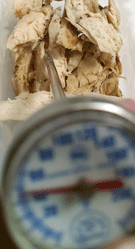 How often do you check your cold hold and hot hold temperatures?
How often do you check your cold hold and hot hold temperatures?
In food service we must be careful to maintain proper temperatures on temperature control for safety foods (TCS), sometimes referred to potentially hazardous foods (PHF’s). Temperature control will control the growth of pathogenic bacteria and other microorganisms that could cause spoilage.
Regulation
Remember, most cold TCS food must be maintained at a temperature of 41°F or below. Some reduced oxygen packaged food and pasteurized crab meat must be held at 38°F or below. Hot foods must be maintained at a temperature of 135°F or above for no more that 4 hours.
Monitoring
Monitoring of these temperatures is critical. How often you monitor depends on what you would want possible corrective actions to be. If you choose to monitor every 4 hours and you discover the temperature of cold food to be above 41°F or hot food being held below 135° F, the only corrective action will be to discard. However, if you monitor every 2 hours you may have sufficient time to take a corrective action that will save your food.
Corrective Action
For cold food you can remove from unit that is not maintaining temperature, quick chill in a different unit or freezer and get temperature down to 41°F or below. Hot food that is below 135°F can be quickly reheated to 165°F or above and your 4 hours starts over.
There is a BUT! This only works if the original temperature reading is verifiable. That means it must have been recorded on the product package or in a log book. The saying goes, “if you didn’t document, you didn’t do it”.
Here is an example: You placed some chicken soup on hot hold at 12 PM. You record temperature and place a sticker on the holding pot. The temperature was recorded at 155°F. At 3 PM a customer complains the soup is cold, you check the temperature and discover the soup is at 100°F. You quickly place soup in a stock pot and reheat. You just saved the soup. But had the temperature not been recorded at 12 PM you could not have taken this corrective action and would have had to discard the soup.
Another example: At 10 AM you check the temperature of you walk in by looking at the thermometer hanging in the warmest part of the unit. It is 38°F, perfect. Around 1:30 PM an employee mentions that the unit feels a little warm. You check and the temperature is 57 °F! Oh no! But since you didn’t write the temperature down it is not verifiable and the TCS food in the walk-in should be discarded.
Same example but this time you recorded the temperature, you check the unit at 12 PM and discovered the unit was 48°F. You immediately call for service, remove TCS food, place in other units for a quick chill, check the temperature of the food at 4PM and it is all 41°F or below and you just saved a lot of money by taking the time to check your cold units every two hours and recording the temperature.
